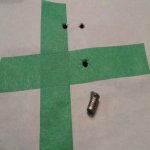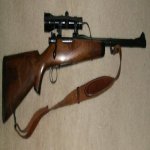You are using an out of date browser. It may not display this or other websites correctly.
You should upgrade or use an alternative browser.
You should upgrade or use an alternative browser.
35 whelen project ideas and help(now 9.3x62mm)
- Thread starter BrianT79
- Start date
I take it as, A firearms owner who owns only bolt action rifles and break action shotguns. All wood no plastic and 100% forsure no "black rifles" and is against any other firearm owner owning anything but a wood stocked "huntin rifle" no hand guns either. Well maybe a revolver but no slide actions.
I take it as, A firearms owner who owns only bolt action rifles and break action shotguns. All wood no plastic and 100% forsure no "black rifles" and is against any other firearm owner owning anything but a wood stocked "huntin rifle" no hand guns either. Well maybe a revolver but no slide actions.
Fudds like lever action and pump rifles too... especially with a 4X scope perched high up on "see-through" rings... a nice beat up walnut stock and some surface pitting adds to the appeal.
Ask Supercub, he’s the president of the club.Ok I"m new here what is Fudd?
Difficult to say exactly but my take;Ok I"m new here what is Fudd?
"Fuddly" is old school thinking to a fault - hating any "new fangled" developments because guns were perfected with wood and steel back when. A "Fudd's" preferred shooting irons will look like your grandfather's rifles. He can be sometimes vocal about his views and close minded. Can be found at shooting clubs and ranges throughout the land. Of course there are degrees of "fuddlyness" - most of us have some element of it ourselves.
- Location
- In the shadows of the Rockies
Elmer Fudd? Old Fuddy-Duddy? 
Here's a fictional FUDD:
Name: Ed Mulder
Age: 53
Employment: Auto Mechanic
Guns: 3; 1 Mauser 98 sporter, 1 Remington 870 shotgun, and 1 Ruger 10/22.
Why he owns guns: He likes the sport.
Reaction when offered an AR-15: Grimmace.
2 characteristics normally identify a FUDD.
#1: Very limited range of shooting interests.
#2: Provincialism in applying the Second Amendment. By the estimation of a FUDD, the Second Amendment exists to let him hunt deer,...
https://www.urbandictionary.com/define.php?term=Fudd
Here's a fictional FUDD:
Name: Ed Mulder
Age: 53
Employment: Auto Mechanic
Guns: 3; 1 Mauser 98 sporter, 1 Remington 870 shotgun, and 1 Ruger 10/22.
Why he owns guns: He likes the sport.
Reaction when offered an AR-15: Grimmace.
2 characteristics normally identify a FUDD.
#1: Very limited range of shooting interests.
#2: Provincialism in applying the Second Amendment. By the estimation of a FUDD, the Second Amendment exists to let him hunt deer,...
https://www.urbandictionary.com/define.php?term=Fudd
Ok I"m new here what is Fudd?
Most of the Fuddism here is a joke but there are some true hardcore Fudds out there that hate anything made past the middle 60s. It's all blued steel and walnut with an absolute disdain for anything outside the classic guns train of thought. A true Fudd does not consider any guns outside the realm of what they own as valid.
I joke about Fuddism a lot but in reality I'm not as think as you Fudd I am.
...... I joke about Fuddism a lot but in reality I'm not as think as you Fudd I am.
Hah! The president of the club, and you expect us to believe that!
Ted
- Location
- Somewhere on the Hudson Bay Coast
What twist barrel in 9.3x62mm gives the best results with the 250gr to 300gr
I expect the majority of 9.3 barrels have a 1:14 twist while some have 1:12. If I was ordering a barrel today I'd specify a 1:10, which tends to fly in the face of common wisdom, which recommends the minimum amount of twist necessary to stabilize a given bullet. My logic is that the fast twist ensures that any bullet I'm likely to encounter will stabilize, regardless of weight, construction, or design, and the the high rotational velocity reduces the precession time of the bullet after impact. Since the bullet is in yaw for a shorter period of time, bullet expansion is uniform rather than askew, the heal of a solid will not squash, and penetration in either case is enhanced. The disadvantage of a very fast twist is that thin jacketed bullets (unlikely in a 9.3) can grenade, and cast bullets must be loaded to very low velocities (1200 fps) to prevent them from stripping badly.
Hah! The president of the club, and you expect us to believe that!
Ted
Which one are you? ........ The pot or the kettle?
Which one are you? ........ The pot or the kettle?
I think he's the spoon...... lol
Hah! The president of the club, and you expect us to believe that!
Ted
yes i agree a strongly supporter of the whelen cant be trusted lol .... as superbrad i m more on the spoon side ...
Paul: i told you so. you can t go from the 375 to the 35 without stopping at 366 ...
I expect the majority of 9.3 barrels have a 1:14 twist while some have 1:12. If I was ordering a barrel today I'd specify a 1:10, which tends to fly in the face of common wisdom, which recommends the minimum amount of twist necessary to stabilize a given bullet. My logic is that the fast twist ensures that any bullet I'm likely to encounter will stabilize, regardless of weight, construction, or design, and the the high rotational velocity reduces the precession time of the bullet after impact. Since the bullet is in yaw for a shorter period of time, bullet expansion is uniform rather than askew, the heal of a solid will not squash, and penetration in either case is enhanced. The disadvantage of a very fast twist is that thin jacketed bullets (unlikely in a 9.3) can grenade, and cast bullets must be loaded to very low velocities (1200 fps) to prevent them from stripping badly.
Right on. As for using lead bullets, I have done quite a bit of shooting with 285 gr cast. Have posted here, in another thread, about the 9.3 with 1:14 barrels driving them past 2200fps without leading the bore. You can see here there is no deformation of the bullet's base or skidding of the bullet shank in the rifling. They group two inches at 100 yards, are inexpensive to practice with, and an adequate hunting load.

The bullet in the picture was caught in the sixth jug of a lineup of an eight four liter water jugs test.
The 1:14 twist stabilizes the Woodleigh 320 and Norma 325gr RN bullets with no problem at all. The amazing thing is that the 9.3X62 drives these very heavy bullets well past 2300 fps. These loads are not for the faint of heart, however.
As for the 35 Whelen, some factory barrels are 1:16 twist, and will stabilize 250 gr spitzers with no problem. The 358 Winchester does the same with 1:16 barrels. I would expect them to be able to handle cast bullets very well also.
Ted
Attachments
Last edited:
Ok here is the current update smith is looking for a barrel 1in14 twist .366 cal and a 9.3x62mm reamer rifle will end up a with a 20" barrel decision was easily made due to the fact my local gun shop has dies brass bullets and factory loaded ammo in stock for the 9.3x62mm but couldnt tell me when they would be able to get 35cal bullets in so anyone who voted for me to put together a kimber 84 classic select in 9.3x62mm seems that you'll get your wish preventing any unforeseen problems
- Location
- In the shadows of the Rockies
Note that Ruger in their wisdom uses a 1:10 twist barrel for their 9.3x62 (and 9.3x74R) rifles.
https://www.cheaperthandirt.com/product/ruger-m77-hawkeye-african-bolt-action-rifle-93x62-23-barrel-4-rounds-american-walnut-stock-satin-blued-barrel-736676371136.do
https://www.cheaperthandirt.com/product/ruger-m77-hawkeye-african-bolt-action-rifle-93x62-23-barrel-4-rounds-american-walnut-stock-satin-blued-barrel-736676371136.do
- Location
- In the shadows of the Rockies
Zastava uses a 360 mm = 14" twist for their 9.3x62 rifles. I've got some 320gr Woodleigh RN bullets for my Ruger No.1 9.3x74R which should stabilize nicely in the 1:10 twist barrel. 
www.impactguns.com/zastava-m70-instandardmagnumin-bolt-action-rifle-cal-243-win-ri1980-n.aspx

www.impactguns.com/zastava-m70-instandardmagnumin-bolt-action-rifle-cal-243-win-ri1980-n.aspx










































































